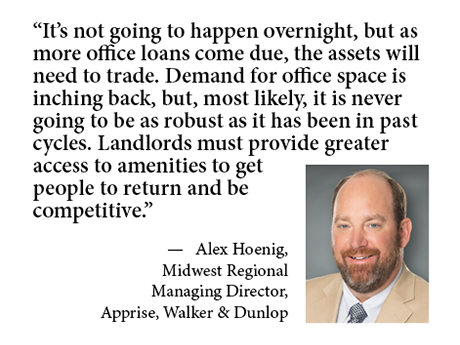The spike in interest rates nearly three years ago brought investment sales to a virtual standstill, as deep disagreements over valuation between buyers and sellers dominated the market. While recent Federal Reserve cuts to the federal funds rate raised hope for a resurgence in transactions, ongoing volatility in the bond market, concerns about reemerging inflation and uncertainty over fiscal and monetary policy continued to weigh on a full-blown rebound in investment activity.
The uncertain environment makes it difficult for investors to easily evaluate commercial property values, underscoring the importance of access to comprehensive, real-time data on transactions, market fundamentals and emerging trends, says Alex Hoenig, MAI, Midwest regional managing director at Apprise, Walker & Dunlop’s independent valuation firm.
“Our understanding of current values for commercial real estate relies on transactions actually taking place, and sales velocity has started to inch back up,” reports Hoenig. “But there’s no question that there has been a lot of volatility in the market, which requires a local expert with access to a strong network and a constant pulse on market comparables.”
Walker & Dunlop launched Apprise in 2020 to accelerate technology-driven solutions in the commercial real estate sector. Apprise serves owners and investors nationwide, with a particular technology focus on the multifamily sector. Hoenig emphasizes the platform’s ability to harness cutting-edge technology to stay ahead of the curve and deliver the best appraisal solutions to its customers.
“Traditional methods for appraisal were typically based on a spreadsheet-based platform. Apprise moved away from that approach to a model that is completely online, and data driven,” he explains. “We not only rely on local appraisers with local expertise, but also integrate data that gets embedded into our appraisals from multiple sources throughout the commercial real estate world.”
Midwest Strength
As commercial property sales slowly return, appraisal volumes are picking up. As it does, Hoenig predicts significant departures in multifamily values between regions based on recent construction activity. In the Midwest, for example, multifamily supply has remained relatively stable, while the Sunbelt has a surge in new construction. Consequently, markets like Chicago, Kansas City and Detroit have experienced positive rent growth, with some of these areas leading the nation at over 3 percent annual growth.
“Nationally, value appreciation has been down overall, and we’ve seen a small increase in multifamily cap rates in the Midwest over the past two years,” he adds. “But from where I’m sitting, Midwest multifamily values are appreciating markedly because of the robust rental rate growth.”
Additionally, multifamily landlords are increasingly supplementing their income through new revenue streams, such as spreading common area utility costs among tenants and charging fees for technology and amenities. According to Hoenig, these supplementary revenues can account for as much as 15 percent of an apartment owner’s gross income. “There are a lot of factors that can contribute to unique properties that aren’t as influential in other situations,” Hoenig says. “That’s another example of where technology enhances our ability to perform, but it’s really important to have the professionals who can take on challenging assignments and bring their expertise to bear.”
Current Catalysts
On a broader scale, several investment trends are shaping the commercial real estate landscape. The continued high demand for industrial properties is driven largely by e-commerce, he says. Meanwhile, retail property buyers are increasingly gravitating toward assets that serve daily needs, such as grocery-anchored centers, as well as open-air projects that have a high preponderance of restaurants, entertainment and other experiential components.
Hoenig anticipates office transactions ticking up in the coming months despite the sector’s challenges. In the commercial mortgage-backed securities (CMBS) market, for example, office delinquencies surpassed 10 percent in November after climbing 100 basis points from the previous month, according to Trepp. However, opportunistic buyers are moving off the sidelines and occupiers continue to gravitate toward the best Class A properties, he observes.
“It won’t happen overnight, but as more office loans come due, these assets will need to trade,” Hoenig adds. “Demand for office space is slowly returning, but it’s unlikely to be as robust as it has been in past cycles. Landlords will need to offer greater access to amenities to remain competitive and attract tenants.”
— By Joe Gose. Walker & Dunlop is a content partner of REBusinessOnline. For more articles from and news about Walker & Dunlop, click here.


